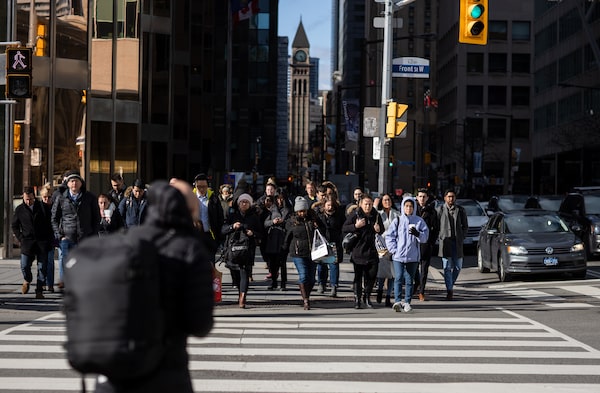
While the rush hour crowds were lower in downtown Toronto, presumably because of the coronavirus pandemic, it was still crowded outside Union Station at 4:30 pm on Friday afternoon.Melissa Tait
The Ontario government has agreed to have health insurance cover some forms of virtual medical care, in a bid to reduce the spread of the novel coronavirus by preventing unnecessary visits to doctors’ offices.
The shift came into effect Saturday and is being praised by doctors, who say it could help reduce the chance of infection.
Coronavirus guide: The latest news on COVID-19 and the toll it’s taking around the world
Who’s ‘flattening the curve’ on the coronavirus, and who isn’t? A global graphic comparison
“What this means is you can still get care from a physician, your physician, without necessarily having to go to their office, where there might be a number of people who are sick to begin with,” Sohail Gandhi, president of the Ontario Medical Association, said Saturday.
Also Saturday, the OMA issued new social-distancing recommendations for its members, urging them to avoid non-essential meetings. Dr. Gandhi said that this was not meant to include patient visits, but that people, while they should not hesitate to see a doctor if necessary, should defer routine matters that can wait a bit.
“There will … probably be some evolution of exactly what’s defined as essential versus non-essential as the situation unfolds over the next week or two,” he said. “Given the current circumstances, those kinds of things that can be put off for a couple or three months, they probably should be.”
The spread of the novel coronavirus that causes COVID-19 continues, with more cases diagnosed in Canada. The Globe offers the dos and don'ts to help slow or stop the spread of the virus in your community.
The Globe and Mail
Some patient visits may be replaced by telephone or video contact under a new Ministry of Health bulletin, issued to doctors Friday. It assigns temporary fee codes, thereby allowing insurance coverage, to some services done over phone or video, including specialist consultation; minor or intermediate assessments of a patient; advice or information given to a patient’s representative; and psychotherapy, psychiatric or primary mental-health care, counselling or interview.
“What we want patients to hear is that family doctors are there for their patients, so the question is how do we do that to keep everybody safe,” said Dr. David Kaplan, chief of clinical quality at the provincial advisory body, Health Quality Ontario.
“The number one thing, outside of obviously things like handwashing and the social distancing, is trying to allow physicians to provide safe care to people who don’t need an office visit, and to encourage them to either speak to their doctor on the phone or see them virtually.”
Dr. Gandhi said that this change followed on the heels of a government policy shift in the fall to allow patient consultations by video.
“With the current situation, there’s obviously going to be much more uptake of that now,” he said. “Sometimes, these events drive the use of new technologies.”
Dr. Duncan Rozario, the chief of surgery for Oakville Trafalgar Memorial Hospital, to the west of Toronto, has been pushing for years for the increased use of virtual medicine and called this week’s change remarkable for its speed.
“To see this happening this rapidly, and implemented overnight, it’s the right thing to do,” he said. “Because as you know, our health-care system has a certain capacity and the current outbreak, unfortunately, has the possibility of overwhelming our capacity.”
Sachin Aggarwal, CEO of the health technology company Think Research, which offers the app VirtualCare, allowing secure doctor-patient communication, believes more extensive adoption of remote medicine is likely to spread.
“It won’t just be the fee codes that make the difference, it’ll be the adoption of the technology. It becomes a part of your workflow for a lot of care providers for whom the fee code doesn’t really matter,” he said.
“It’s just going to change their practice. Once they learn how to do a virtual visit and deliver their care in that manner, a lot of them just aren’t going to go back.”
 Oliver Moore
Oliver Moore